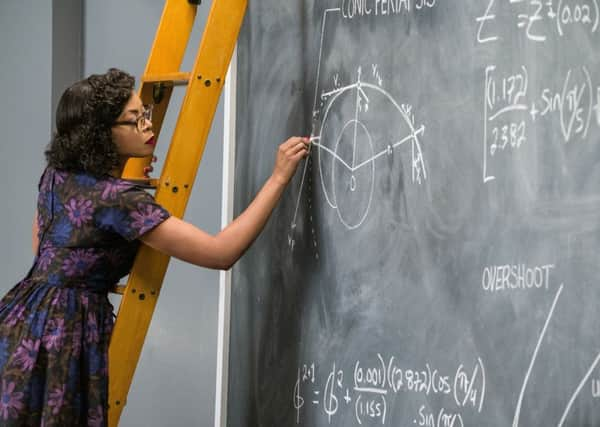Film reviews: Hidden Figures | John Wick Chapter 2 | The Founder | Lost in France


Hidden Figures (PG) ****
John Wick Chapter 2 (15) ****
The Founder (12A) ***
Lost in France (15) ***
Hidden Figures is a story about mathematics at a time when nothing added up in the world. Based on the hitherto little-known story of the black American women who helped win the space race, it turns Margot Lee Shetterly’s non-fiction book of the same name into a joyously entertaining film about overcoming professional and societal odds in a country that frequently forgets the true value of democracy and meritocracy. The film – directed by Theodore Melfi – zeroes in on a trio of math whizzes whose brains have got them through NASA’s doors, only to find other doors marked “coloured” in the halls of its Virginia HQ. In the segregated south of 1961, it doesn’t matter if they have a gift for computing the advanced data required to beat the Russians into space, they’re still not respected enough to share bathrooms or coffee machines with their white colleagues.
So finds Katherine Johnson (Taraji P Henson), a former child prodigy whose abilities are recognised enough to elevate her to the Space Task Group (which has been charged with getting American astronauts safely into space), but whose skin colour and gender preclude her from full security clearance to do the job properly. Her friends Dorothy Vaughn (an Oscar-nominated Octavia Spencer) and Mary Jackson (Moonlight’s Janelle Monáe) have their own issues: the former is vying for the yet-to-materialise promotion and salary she deserves for managing NASA’s computing team; the latter is fighting for the right to boost her own considerable qualifications so she can become NASA’s first female engineer.
Advertisement
Hide AdHidden Figures tells their story in a fairly conventional Hollywood way, but while it may show its working with lots of on-the-nose dialogue, encoded within the formula are plenty of layers of sophistication. When Kevin Costner, cast as Katherine’s idealistic boss, literally uses a sledgehammer to break down a barrier to racial segregation midway through the film, what at first appears to be a groan-worthy concession to the rousing white saviour trope is actually more interesting in the context of the story being told. This is a movie focusing on the multiple, almost imperceptible ways its heroines have to negotiate the strictures of daily life just to be able to do their jobs. None of their white colleagues have to face those barriers, which is why they have to make a big show of tearing them down when their eyes are finally opened to them; their egos practically demand it. It’s a clever way of inverting the norms of this type of filmmaking. By making those traditional, big movie moments feel small, Hidden Figures amplifies the collective achievements of its no-nonsense protagonists, ensuring the story adds up properly this time.
John Wick: Chapter 2 sees the welcome return of Keanu Reeves as the eponymous grief-fuelled hitman who went on a kill-crazy rampage after losing his wife, his puppy and his vintage car in the first film – a cult hit par excellence that came out of nowhere in 2014 to become Reeve’s most essential movie since The Matrix. The new movie picks up where that one left off: with Wick on a brutal mission to retrieve his car from the Russian gangsters who stole it. With a frankly dazzling display of vehicular-, gun- and martial-arts-induced slaughter, the film sets its thrillingly over-the-top tone early. Returning director Chad Stahelski and cinematographer Dan Laustsen craft chiaroscuros of carnage, offsetting the vibrant bloodshed with shadowy lighting to enhance the artfulness of the action (not for nothing do they later set two big set-pieces in museums). Of course there still isn’t much artfulness on display in the script – a stripped-down yet clunky amalgam of B-movie dialogue and paper-thin characters. But what’s pleasing is the way Stahelski and screenwriter Derek Kolstad have built on and expanded the crazy world of the first film instead of just regurgitating the revenge storyline. Reeves, too, is just great to watch. Whether he’s being bounced off concrete steps, deflecting bullets with his Kevlar-lined suit jacket or simply walking across the Brooklyn Bridge with his new dog, he’s in complete command of a role that only he could make work.
Telling the story of McDonald’s and the ruthless way businessman Ray Kroc franchised ownership away from siblings Dick and Mac McDonald, The Founder could be written off as failed Oscar-bait were it not a much better movie than its poor showing on this year’s awards circuit suggests. Starring Michael Keaton as Kroc, John Lee Hancock’s film takes care to neither demonise nor lionise his achievements. Instead it presents both him and the McDonald’s story as a parable of entrepreneurialism gone awry in a country that prizes success over quality.
There’s an interesting tension between filmmaker and subject in Lost in France. Niall McCann’s documentary about rise of the Glaswegian indie label Chemikal Underground is built around a 2015 trip to Brittany with members of The Delgados, Mogwai and Franz Ferdinand to revisit the scene of a music festival that hosted a riotous showcase for the label back in 1997. Trouble is, none of the bands involved remember all that much about it and the return trip feels increasingly like a contrived part on McCann’s part to mythologise something that doesn’t appear to have been all that significant. What is significant is the label itself and the film does a better job of detailing both its origins as a band-based DIY outfit and its changing fortunes as the bottom fell out of the industry. ■